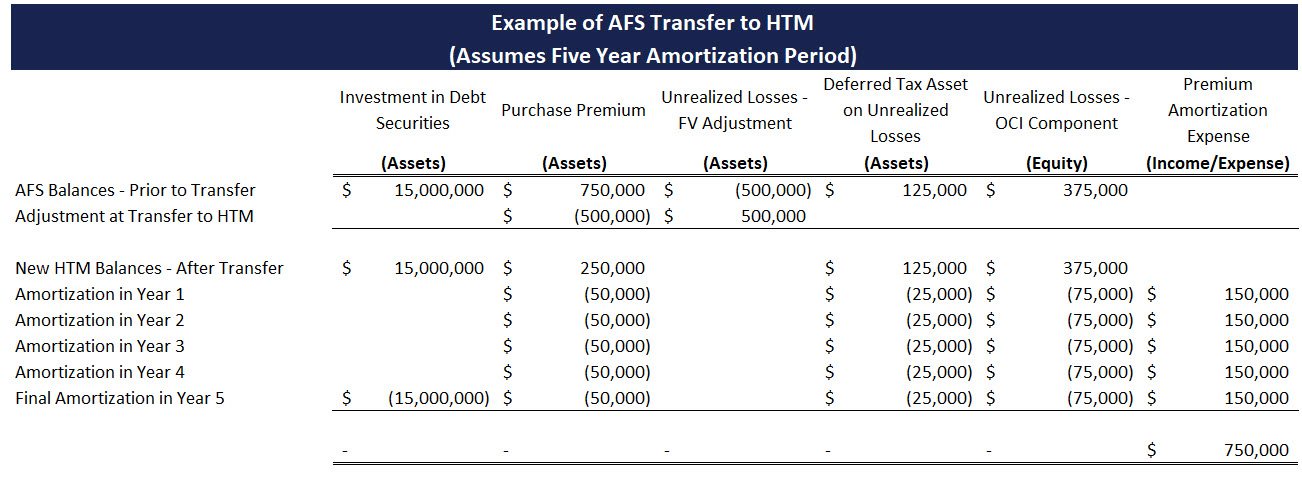Navigating Available-For-Sale Securities in Investment Portfolios
March 23, 2023
There are three main strategies for navigating other comprehensive income (OCI) volatility caused by the changes in fair value of available-for-sale (AFS) securities in a bank’s investment portfolio:
- Cut your losses - sell securities and recognize the loss in net income, and reinvest the sales proceeds.
- Do nothing, keep the securities in AFS and wait for portfolio performance to improve.
- Mark the securities as “held-to-maturity” (HTM) and amortize losses over time.
- Sell securities today, recognize investment losses, and reinvest the liquidated cash to restructure the portfolio.
Rising Rates and Pressure on AFS Securities
The reemergence of inflation and uncertain market expectations have pushed Treasury rates significantly higher across the yield curve. For many financial institutions who increased the size of their investment portfolios in response to the deposit-rich environment experienced during the COVID-19 pandemic, the aggressive rise in market rates triggered steep declines in their portfolio values and resulted in large mark-to-market unrealized losses in their investment portfolios. According to one article by S&P Capital IQ, unrealized losses in securities portfolios of banks accelerated in the third quarter of 2022. U.S. banks posted accumulated other comprehensive income (AOCI) losses of $347.83 billion in the third quarter of 2022, bringing the total for the first nine months of the year to $771.39 billion. With the widespread deterioration of securities portfolios, more than 4,000 U.S. banks posted AOCI deterioration in the third quarter of 2022 while only 40 banks posted a year-over-year improvement and 110 banks posted a quarter-over-quarter improvement.
In today’s environment, where deposits are becoming more competitive and loan demand remains elevated, financial institutions may experience funding pressures as underwater securities may no longer represent a reasonable source of liquidity. As a result, financial institutions are seeing portfolio losses weigh on expenses and tangible capital, as well as cause asset-liability strategy mismatches. While every financial institution’s path forward will be different, we present three possible options for how financial institutions may navigate the continued uncertainty going in 2023.
The biggest question on every investor’s mind is the future path of interest rates. With the market environment so dramatically changed in the prior year, as evidenced in Figure 1, many are beginning to wonder when we will enter the next down-rate cycle.
Figure 1:

Source: United States Department of Treasury
There also remains the possibility of a scenario where the Federal Reserve does not manage to cool inflation and has to continue its path of higher rate hikes. If expectations lean toward higher rates in the near term, it may be best to try to “stop the bleeding” on further OCI losses.
Selling Securities Today
Among the most straightforward of the scenarios, selling underwater AFS securities today would require financial institutions to recognize associated investment losses. The immediate sale of depressed securities could help to address immediate liquidity needs, assuming other potential liquidity avenues have been exhausted. Outside of addressing an immediate liquidity requirement, the other opportunity that selling securities today could present is to allow a financial institution to reinvest the proceeds into higher yielding, more profitable opportunities today. This restructuring would allow a financial institution to curb losses today while the higher yielding income stream should help offset losses over an extended investment horizon. Still, unrealized losses in the portfolio would become realized and directly impact net income levels.
Figure 2: Annual Income Stream from Restructuring a Mock Portfolio

Rates from U.S. Department of Treasury. Hypothetical pricing for demonstration purposes only. * Includes recognized $12.50 loss from sale of security
As always, a financial institution should appropriately assess how a sale and restructure of its AFS securities portfolio impacts both its profitability and broader asset-liability management strategy. Financial institutions should also consult with their accountants and tax advisors before deciding to utilize this option.
The Option to Do Nothing
One powerful alternative to a sale of AFS securities is to delay in anticipation of a stabilization in interest rates or a modest improvement in investment performance. The latest economic data reports have suggested a tapering in inflation acceleration levels, resulting in more positive fixed income investor sentiment and an increase in asset prices. If a financial institution believes that the Federal Reserve can successfully accomplish a “soft landing”, and that its balance sheet can weather potential downside risk to negative tangible capital or a potential liquidity crunch, a reasonable approach may be to maintain the securities in AFS in anticipation of future price gains and ease of monetary policy.Figure 3: Modeled Portfolio Price Changes in Varying Interest Rate Shock Scenarios
Hypothetical bond portfolio including 45% US Treasury securities and 55% Agency MBS securities. Includes a snapshot of where prices were across different rate shock scenarios on 9/30/2022 and on 12/16/2022. Price gains were seen across the portfolio in most rate shock scenarios, despite two FOMC rate hikes during time span.
Even if a financial institution can weather the accumulation of mark to market losses in OCI for the time being, temporarily surrendering the liquidity of the portfolio or a portion of the portfolio could have repercussions elsewhere. Maintaining underwater securities in AFS would have to be balanced with any loan demand and continued deposit run-off. While investment losses might be tempered by waiting for a better environment in the future, a financial institution might have to tap other liquidity sources to meet continued loan demand and balance deposit run-off, or pay up to acquire new deposits. This introduces the potential of increasing their cost of funds and compressing margins. This consideration should also be weighed against the possibility of a scenario where the Federal Reserve cannot tame inflation and has to continue increasing rate hike forecasts.
Move Securities to Held to Maturity and Realize Losses
The final option to explore to curb investment portfolio losses, especially in anticipation of yet higher interest rates in the near term, is to transfer AFS securities into the HTM category. In accordance with ASC 320-10-35-10B, an institution is permitted to reclassify and transfer a security to the HTM category at its amortized cost basis, if the entity has positive intent and ability to hold these securities until maturity. Any unrealized loss may be amortized over the remaining life of the security as an adjustment of yield in a manner consistent with the amortization of any purchased premium or discount. In addition, the deferred tax assets arising from unrealized losses, as well as the OCI component in equity, become frozen at the time securities are transferred, as demonstrated in Figure 4 below (does not consider credit losses):
Figure 4:

While the transfer does not eliminate losses accumulated in OCI, a move to HTM would prevent any further loss build-up in AOCI and permits a financial institution to recognize the losses over an amortization schedule. The major caveat is that once moved to the HTM category, current accounting guidance stresses an entity leave the securities in HTM to avoid “tainting the portfolio”. Sales of securities from an HTM portfolio can call into question a financial institution’s assertions regarding its ability and intent to hold to maturity its entire HTM portfolio.
This move could also significantly alter an asset-liability management strategy. Financial institutions should only explore this option if they are comfortable with holding these transferred assets to maturity, e.g. if they anticipate faster-than-expected asset prepayments, or are able to efficiently manage the new interest rate risk parameters through the asset’s maturity. However, if a financial institution moves a security out of HTM, they cannot use the HTM designation for at least two years and instead must use the AFS category and will have to mark to market interest rate volatility through equity.
Financial institutions should also consider that the securities transferred to HTM are required to be assessed for impairment under the current expected credit loss (CECL) model. Financial institutions should consult with their accountants and tax advisors before deciding to utilize this option.
The Bottom Line
As always, financial institutions can rely on the Federal Home Loan Bank of Chicago (FHLBank Chicago) as a source of contingent liquidity. As long as a financial institution can absorb the impacts to tangible capital without going negative, the best solution might be to leave securities in AFS, wait for improvement in security performance, and utilize the FHLBank Chicago for any interim liquidity needs. Financial institutions could also explore the option of pledging certain securities that meet collateral eligibility guidelines to ensure that they are maximizing their potential borrowing capacity before a sudden need to borrow arises.
To Learn More
Contact your Sales Director or email membership@fhlbc.com if you want to learn more about advance strategies using alternative reference rates to lower your all-in cost of borrowing.
Contributors
 | Danny Magdaleno | |
 | Tommy Priest |


